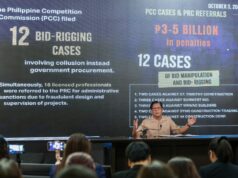Nomura still thinks BSP will hold rates steady, but changes view on RRR
NOMURA Global Research reiterated its view that the Bangko Sentral ng Pilipinas (BSP) will keep policy rates unchanged until mid-2018 amid broad-based government reforms, but added that it no longer believes the BSP will cut the reserve requirement ratio (RRR) in the near term.
“On monetary policy, we maintain our view that BSP will keep its policy rates unchanged before hiking them in H2 2018,” according to a report by Nomura economist Euben Paracuelles.
The central bank has kept its monetary policy stance unchanged since a rate hike in September 2014, aside from procedural cuts introduced in June last year connected to the introduction of an interest rate corridor scheme designed to better siphon off excess liquidity and influence market rates.
Nomura said that it no longer sees a possible cut in the bank reserve requirement due to low inflation levels in its previous forecast.
“We no longer judge this to be the case, given the emphasis on tying these moves with longer-term financial sector reforms,” Mr. Paracuelles said.
The Nomura analyst cited the central bank’s deepening of the peso bond market, as well as the planned derivatives framework in repurchase markets.
Nomura said that the outlook for the Philippine economy remains positive given the government’s “better” execution of reforms and the rolling out of infrastructure projects, after analysts attended the government’s economic roadshow in Tokyo last week.
“The key messages in the briefing and panel discussions reinforce our long-held positive view on the growth outlook for the Philippines,” the report said.
“What also came across clearly to us was a comprehensive approach to deliver a broader reform agenda and a strong sense of coordination among policymakers,” he added.
Moreover, Nomura sees the two major market movers – the tax reform program and infrastructure projects – to be on track, “given the strong commitment of economic managers to see them through.”
It also noted that there is a “very strong” sense of priority and urgency on the implementation of infrastructure projects.
“The coordination between the various cabinet members – the economics team and implementing agencies alike – appears to be very solid, and this should augur well for more progress on implementation.”
The government plans to spend P8.4 trillion on infrastructure over the medium term equivalent to 7.1% of gross domestic product, from a 5.4% level set this year. Such a spending plan is intended to grow the economy at an annual 7-8% from 2018 to 2022.
“But beyond these catalysts, what also came across clearly to us was that the reforms look more broad-based than is likely appreciated by investors.”
Mr. Paracuelles was referring to reforms intended to cut red tape and corruption and to speed up business and government processes; significantly cuts to the foreign investment negative investment list, the one-year shelf life of appropriations in the Budget reform bill, as well as the trimming of bureaucracy through a government rightsizing program. – Elijah Joseph C. Tubayan



